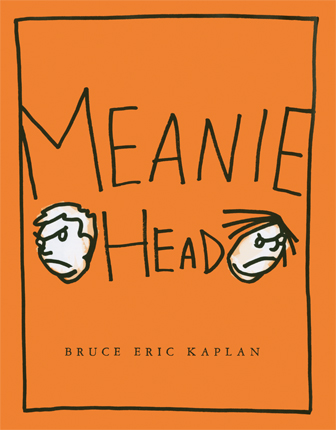| Meaniehead Author: Kaplan, Bruce Eric | ||
| Price: $6.50 | ||
Summary:
Henry and Eve are going through a phase of fighting with each other all the time, and their battle quickly escalates from arguing over a toy to leaving a path of destruction across the United States and beyond.
| Accelerated Reader Information: Interest Level: LG Reading Level: 3.50 Points: .5 Quiz: 168062 |
Reviews:
Kirkus Reviews (05/01/14)
School Library Journal (-) (06/01/14)
Booklist (06/01/14)
The Bulletin of the Center for Children's Books (09/14)
Full Text Reviews:
Booklist - 06/01/2014 Kaplan’s id fest introduces two siblings, Henry and Eve, who are going through a new, terrible phase of fighting with each other all the time. One day they both reach for the same action figure—and, well, that’s all she wrote. Shouting escalates to a broken lamp, which escalates to a destroyed bedroom, which escalates to a burned-down house. And they’re just getting started! Eve bulldozes the whole town in a fit of rage, and then—after a snack break—the deleterious duo ruin the San Diego Zoo, flatten the Grand Canyon, set off Hawaii’s volcanoes, and destroy Earth. Not too shabby for one day. Kaplan’s characters look like angry little voodoo dolls, squiggled with loose lines, blotched with muddles of watercolor paint, and then placed upon large stretches of white background with the barest accompaniment of props. With deceptive simplicity, Kaplan accurately depicts the classic red-faced fight that, ever so slowly, becomes a fellowship of gleeful havoc. Everyone is friends by the end; in other words, let the havoc continue! - Copyright 2014 Booklist.
School Library Journal - 06/01/2014 Gr 1–3—Henry and Eve, the expressively drawn protagonists from Monsters Eat Whiny Children (S. & S., 2010), are back for a new adventure. This time, instead of whining, the children are in a "new, terrible phase of fighting with each other all the time." Their battle quickly escalates from the plausible breaking of their mother's favorite lamp to the regrettable action of leveling the Grand Canyon and continues until they end up destroying the whole world and floating alone in space. In the emptiness of space, they decide they are done fighting and drift off hand-in-hand, "Ready for their next adventure." As with Monsters, readers who do not appreciate dark humor will likely find this book strange and off-putting, but this title lacks the tongue-in-cheek charm that makes the previous book appealing and successful. The children are the villains here instead of the bumbling monsters, and their bad behavior has no counterpoint to make them relatable. At the end, they simply decide to stop fighting because they want to, continuing their selfishness. Aside from the extreme escalation of the fight, the story follows a static, predictable course without a satisfying or clever resolution. The heavy line drawings with watercolor washes are emotive and suited to the text, but since the story takes place in a world full of negative emotions, they ultimately make the children seem even more unsympathetic. Most libraries will be comfortable sticking with Henry and Eve's first adventure and passing on this one.—Anna Haase Krueger, Ramsey County Library, MN - Copyright 2014 Publishers Weekly, Library Journal and/or School Library Journal used with permission.
Bulletin for the Center... - 09/01/2014 When siblings Eve and Henry reach for the same action figure, their bickering takes an epic turn. Before long, they have burned down the house, flattened the town, decimated the country, and destroyed the planet in their heedless, needless fighting, and only as they float in space, far from one another, do they decide that they don’t want to argue anymore. Author and illustrator Kaplan brings his signature New Yorker cartoon style to this absurdist story, depicting Henry and Eve as iris-less, stumpy figures whose line mouths and eyebrows convey their emotions in ink and watercolor art against gleaming white backgrounds. Though the dryness of the humor and spareness of the art may send this over some kids’ heads, others will appreciate the hyperbolic humor, and those familiar with sibling squabbles may just nod their heads in complete agreement. AA - Copyright 2014 The Board of Trustees of the University of Illinois.



